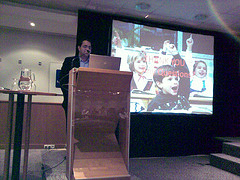Think big, act small, scale fast – advice from Procter & Gamble on mobile advertising
 At the MMA mobile marketing forum in Budapest last week, I heard an excellent keynote on day 2 from Khurram Hamid who is Global Head of Mobile Marketing for Procter & Gamble.
At the MMA mobile marketing forum in Budapest last week, I heard an excellent keynote on day 2 from Khurram Hamid who is Global Head of Mobile Marketing for Procter & Gamble.
Now first off, for a major brand such as P&G have their own global mobile marketing head shows that P&G are serious about mobile.
Khurram definitely gets mobile, but also has a vision of where it should go. During his excellent presentation, he talked about the P&G innovation group that is looking at all things mobile. I sat next to him just before he presented and he said that they are “open to everything” – clearly keen to learn about new concepts and what is coming next that they can leverage across a massive 350 products in 54 countries.
He has a focus on the moment in the emerging markets of Brazil, Russia and China and wants to be able to use mobile as a way of having low income customers interact with their brands in a very positive and meaningful way.
To illustrate his point, he showed a short video (embedded below) from Idea Cellular which shows the power of mobile in these emerging markets. Some of the concepts shown in the video we would never even think of in our western markets because we have ubiquity of communication.
A few of the key points from Khurram’s keynote are listed below:
- 50% of new products come from external collaboration
- There are more mobiles than credit cards and TV’s
- It’s about “movergence” not convergence – all coming to the one phone
- P&G are hedging their bets that consumers will access the internet via their phone
- It is not your consumer, not my consumer, they are our consumers
- Vendors should work with the brands to develop a model to make the experience for the consumer relevant
- Understand the consumer and their receptability to advertising
He also spoke about the 3 roles that mobile plays across different markets
Support role – consumers have access to TV’s and computers – mobile is not the focus
Lead character – consumers have limited access to other entertainment devices and info vehicles – the mobile device serves as a surrogate device (camera + a phone) and plays more important role than above
Hero– consumers use mobiles as their only communication, information and entertainment store so mobile is the hero in this scenario. Indeed, in some emerging markets, their only access to the internet will be from their mobile.
The key question remains … how do we reach these new “mobile” consumers?
- The size of the prize and mobile dependence drives mobile prime prospects
- We learn and we incubate
- We develop relationships and partnership
- A “click through rate” doesn’t mean anything for a brand wanting to go mobile
- Brands don’t measure product sales with CTR and impression
- Brands want a a holistic campaign across TV, radio, online AND mobile
- TV does not give a marketer the reach it gave 2 years ago
- Generation Y is constantly multitasking and distracted
At the end of the day what a band manager wants to know is did this advertisement/communication affect brand equity and brand awareness and is the consumer now more disposed to purchase my product? (notice there is no mention of CTR or CPM in that sentence).
P&G has been a TV centric company for 70 years, but their consumers and media are changing and so they recognise they need to change too. Mobile advertising companies need to think like a brand: and the dynamics of media is changing … so how do you make the medium work for you in terms of brand goals?
P&G are also sponsoring info services in rural communities, which is a critical component of their overall strategy, and they have launched a number of relationship platforms:
- being girl – teen girl relationship platform 45 countries – let’s have a discussion – how are you feeling – what do you think of our product
- Pampers.com – for Mothers in 53 countries
The plan for P&G is to incubate and scale across 350 brands in 54 markets and hence “think global and act local”.
Brand Managers have vast value chain in front of them and they need to make choices. A brand Manager will not brief all these agencies so if we as an industry make it easy, then as Khurram puts it “you will get the money”.
The key takeaways for me from Khurram’s talk were:
- Mobile vendors need to learn marketing, and marketing players need to learn mobile
- Mobile is the first truly global direct to consumer mass medium for the 21st century
- The planning agency should be in the lead (like an extended family) – eg Group M and Publicis
- Sometimes the key agencies are very slow and the brand needs to navigate outside to get things done
- We are seeing the same attitude with online a few years ago – and only spending small amounts on mobile
- The Starcoms etc need to be the leaders – if you’re not going to be there we’ll have to bypass you
His final thoughts, and the heading of this post was simply
Think big, act small, scale fast.
Excellent advice indeed.
Russell Buckley was also at the presentation and his thoughts can be found at Mobhappy.